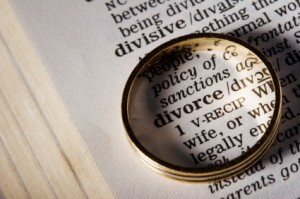This paper is part of the Council on Contemporary Families’ Online Symposium “New Inequalities.”.
It is quite likely that the economic crisis both caused some divorces and prevented some divorces. However, the balance of the evidence suggests it prevented more than it caused. I would not read this as good news for marriage and families, however, because there may be negative consequences for people who want to part but cannot divorce because of economic constraints. The enforced wait could simply prolong or exacerbate marital stress and family conflict, rather than saving or restoring a happy marriage.
–Stephanie Coontz
In the wake of several news reports claiming that a falling divorce rate was the “silver lining” around the clouds of the Great Recession, I analyzed divorce patterns using the American Community Survey (ACS) from 2008 to 2011 to look for evidence of whether the economic crisis had increased or decreased the divorce rate. On the one hand, economic stress, job loss, and home foreclosure tend to be associated with marital tension and thus might be expected to increase the number of divorces. On the other hand, divorce is expensive, especially the cost of establishing a new household, and people who can’t sell their homes, or who have suffered a job loss, might not be able to manage a divorce and thus end up postponing or foregoing it.
My research shows that the divorce rate fell from 20.9 per 1,000 married women in 2008 to 19.5 in 2009, before rebounding to 19.8 in 2010 and 2011. It is not immediately clear that this was a response to the recession, because divorce rates had been falling for several years prior to the economic crisis. By looking at demographic predictors of divorce, however – age, duration of marriage, number of times married, education, race/ethnicity, and nativity – I was able to determine how many divorces would have been expected in 2009-2011 absent the crisis. From this, I calculated that the crisis had indeed provoked a drop in total divorces, resulting in about four percent — or about 150,000 – fewer divorces than would have been expected to occur in those three years. On the other hand, I found some evidence of a partial counter-trend, with divorce rates increasing in states with higher home foreclosure rates.Since my original analysis was published, the 2012 ACS has been released, showing a continued increase in the divorce rate, up to 20.0 per 1,000 married women. This supports the idea that the 2009 drop was a one-time event tied to the recession.

In summary, it is quite likely that the economic crisis both caused some divorces and prevented some divorces. However, the balance of the evidence suggests it prevented more
than it caused. I would not read this as good news for marriage and families, however, because there may be negative consequences for people who want to part but cannot divorce because of economic constraints. The enforced wait could simply prolong or exacerbate marital stress and family conflict, rather than saving or restoring a happy marriage.
Assessing the impact of the recession on the marriage rate is more complicated. The American Community Survey shows an increase in the number of marriages in 2012, and also
an increase in the marriage rate per 1,000 unmarried women. That’s just a one year uptick, but it’s consistent with the possibility that the recession held down marriages just as it held down divorces, and that some postponed marriages may now take place. However, we don’t have the NCHS vital statistics numbers for 2012 yet, and as of 2011 they still show a decline.
For births, the big story is the drop in birth rates during the recession for almost all women. On average, the drop in birth rates has been steeper for single women, and their birth rates haven’t bottomed out yet, while married women’s birth rates started edging back up in 2011 and 2012. As a result, unmarried births peaked at 41.0 percent of all births in 2009, and have since slipped to 40.7 percent. It’s a tiny drop, but after increasing for several decades, three straight years of no increase in the share of births to unmarried women is certainly interesting news.
Just as interesting is the difference in birth trends for unmarried women under 35 and unmarried women aged 35-44. The birth rate for unmarried women under age 35 has now fallen every year since 2007. But the non-marital birth rate for women aged 35-39 was seven percent higher in 2012 than in 2007, while the non-marital birth rate for women aged 40-44 was 29 percent higher.
—
For the source of my calculations, see Philip N. Cohen. “Recession and Divorce in the United States, 2008-2011.” Population Research and Policy Review 33(5):615-628. It is available here: http://www.terpconnect.umd.edu/~pnc/PRPR14.pdf. The 2012 update is posted here: https://familyinequality.wordpress.com/2014/01/03/divorce-recession-drop-rebound-with-the-2012-rate/

Comments